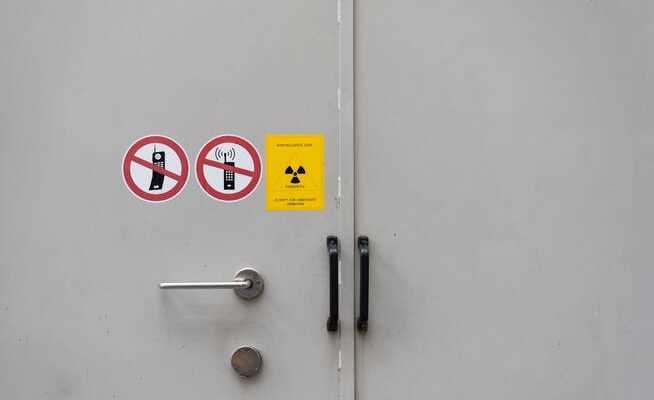Power outages would be a disaster, business groups say. They criticize the fact that the federal government relies unilaterally on storage power plants to ensure security of supply. However, their plans ultimately see the state at the wheel.
How long should nuclear power plants (Beznau in the picture) be allowed to run?
It was a shock for the industry: last autumn, a letter landed on the desks of around 30,000 large electricity consumers, in which the federal government asked them to prepare for rationing. This was preceded by an analysis by the Electricity Commission (Elcom), which showed that there could be a longer power outage as early as 2025 if, for example, a third of the French nuclear power plants and the two Beznau blocks in Switzerland failed.
Such a shortage would be a disaster, said Economiesuisse President Christoph Mäder in Bern on Wednesday. A power outage quickly costs billions. The umbrella organization has therefore worked out a battle plan together with the pharmaceutical, chemical and machine industries on how Switzerland should achieve a secure electricity supply.
Absolute openness to technology
One sentence from the paper is striking: Funding, planning and steering alone cannot guarantee the conversion of the energy system; intelligent incentives and market forces are also required. Even the business associations, one has to conclude, therefore see the state as primarily at the helm when it comes to a secure energy supply.
This is also reflected in their main proposal, a threshold value for imports: If this is threatened to be exceeded in five to eight years, additional capacities from CO2-free sources are built. Specifically, it is about imports in winter. On average, Switzerland imports around 4 terawatt hours (TWh) of electricity from neighboring countries. In 2016, it was 10 TWh due to nuclear power plant failures, which brought the system to the limit. A further complication is that the EU countries primarily handle the exchange of electricity among themselves. Since an electricity agreement with the EU is currently out of reach, Switzerland can only hope for limited help from outside in the event of a shortage.
The trade associations base their proposal on Elcom, which considers imports of 10 TWh in the winter half-year to be just manageable for the infrastructure. Should the youngest Swiss nuclear power plant in Leibstadt be shut down in 2034 after fifty years, the federal government estimates that the import requirement would already be 14 TWh. On the other hand, if the nuclear power plants were left connected to the grid for sixty years, this would be the case ten years later.
Since the security of supply is a public good, it is difficult to avoid a certain state activity. But the question is how best to guarantee this security. With the threshold value, the trade associations rely on an automatism, whereby they rely heavily on the regulatory authority Elcom. However, how exactly this approach is supposed to work, what capacities are involved and how these are ensured remained open. After all, market mechanisms should come into play when it comes to expansion. “Absolute openness to the technology” is required here, the business associations are demanding.
Stagnant electricity market liberalization
The fact that the Federal Council is only relying on storage hydroelectric power plants by 2030 contradicts this principle. However, the suggestion by industry that existing power plants such as nuclear power plants should also be able to participate in the tender is likely to be controversial. Since the operation of nuclear power plants in Switzerland does not have a time limit, there could be windfall gains – that is, that an operator receives money although he would let the nuclear power plants continue to run anyway. In any case, there are also reasons for a restriction to new capacities.
After the failure of the framework agreement with the EU, access to the EU internal electricity market is not possible until further notice. Nevertheless, the business representatives are calling for Switzerland to prepare itself in the event of stronger cooperation in the course of the Ukraine war. One prerequisite would be full liberalisation, meaning that Swiss consumers would also be able to choose their supplier freely. This would also advance business models for renewable energies. However, even bourgeois politicians seem to lack the courage here. In this case, they point to the guaranteed referendum from the left, which would jeopardize the entire reform.
Last autumn, the councils extended the subsidies for renewable energies until 2030, although it had always been said that such subsidies were intended as start-up financing. That doesn’t go well with statements that photovoltaics have long been competitive. The “market premium” for large-scale hydropower – ultimately a guaranteed minimum compensation – now also applies until 2030.
The network surcharges – 2.3 centimes per kilowatt hour for the promotion of renewables alone – naturally affect energy-intensive sectors the most. The trade associations therefore propose that companies should be given back the contract if they commit to saving electricity by means of target agreements with the federal government.
However, because the price of electricity is very high, companies already have a strong incentive to reduce their demand. How are you supposed to distinguish between additional efforts and those that companies would have made anyway? In addition, the pressure on politicians to stop subsidization by 2030 at the latest would decrease if companies could simply shake off this burden. The discussion in Bern also showed that the battle over who should bear the costs of security of supply has now begun.
